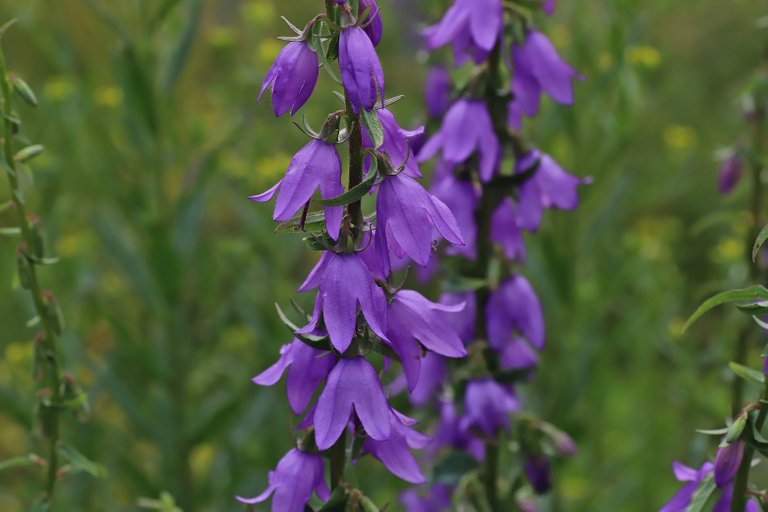
Today I took a few minutes to photograph and study a wildflower that I was unfamiliar with.
After combing through books and searching some online catalogs I am quite confident that I've properly identified it at the European Bellflower (creeping bellflower) Campanula rapunculoides L.
This is a European introduction and like many introduced species, it is considered invasive. Whenever I learn that a wild plant is non-native I immediately become curious about the medicinal and culinary uses. Early settlers were thinking about edible and medicinal plants and survival when they packed their bags and traveled to North America. Although they might cause some trouble in their non-native landscape most of these plants are very useful. If they are here to stay, why not find out if they can benefit you in some way rather than trying to eradicate these plants with chemicals?
Campanula rapunculus is also known as rampion (not to be mistaken for ramps/wild garlic which is a different species). In German, it is known as Rapunzel and if you are familiar with the Brothers Grimm fairy tale Rapunzel you might recall that the story begins with a pregnant mother developing an insatiable need for rampion. In the story, the husband climbs over the wall and steals some rampion from the wicked witches garden. He gets caught and as punishment, the witch takes the child and names her Rapunzel. In 1812 when this tale was written this plant was a common kitchen garden vegetable, the leaves, shoots, and roots are edible.
Fortunately, I don't have to steal any as it is growing wild around us. I am eager to taste it and figure out how to use this plant in our kitchen. A bi-annual plant, it is best when grown for culinary use that you don't allow it to flower so that growth is focused on the roots, much like the removal of garlic scapes when you want large bulbs of garlic. I'll have to experiment.

You've been visited by @minismallholding from Homesteaders Co-op.
I never looked at it that way. I always assumed invasive plants were originally brought over to make gardens look pretty. I’ve featured your post in the Homesteaders – Living Naturally newsletter
A community marketplace of ethical, handmade and sustainable products available for STEEM, SBD (and USD): https://homesteaderscoop.com
follow: @homesteaderscoop
I have Canterbury bells and balloonflower which are both cousins of bellflower, I believe. It is interesting that this was a common garden plant way back. It's a lovely flower, and your photos are gorgeous. :))
Thank you, I really never would have guessed that it was a kitchen vegetable opposed to being simply ornamental. Quite thrilled with this discovery. It is very pretty, I'll have to keep notes on where they are growing so we can try to cultivate it as a vegetable and see what we think.
You've been visited by @nateonsteemit from Homesteaders Co-op.
Cool point about invasives being useful! I'd wondered on that topic before, thanks for confirming :)
A community marketplace of ethical, handmade and sustainable products available for STEEM, SBD (and USD): https://homesteaderscoop.com
follow: @homesteaderscoop
Congratulations @walkerland! You have completed the following achievement on the Steem blockchain and have been rewarded with new badge(s) :
You can view your badges on your Steem Board and compare to others on the Steem Ranking
If you no longer want to receive notifications, reply to this comment with the word
STOPTo support your work, I also upvoted your post!
Vote for @Steemitboard as a witness to get one more award and increased upvotes!
I made the mistake of transplanting some in my garden and I know why they are considered invasive! They have a tough root to eradicate and they multiply quite quickly taking over plants that are not so rugged! I made a bed just for them that they can do their thing but they spread by seed too so it seems I'm always digging up the young plants before they take hold. The roots can get quite succulent so it's good to know they are edible! The hummingbirds love them and I think they are beautiful but I would be careful where you pur them.
yes, these are wild so I haven't got much say in where they grow. I made that same mistake with lupin and it's becoming a bit of a headache because it swallows up so many other plants.
Saludos soy de ciudad Guayana Venezuela y me encanto leer tu publicación , cuando vi la foto pensé que era lavanda pero luego cuando seguí leyendo y supe que era una Campanula europea Rapunculoides gusto mucho mas , las fotos son excelentes pero lo que mas me gusto fue las reseña que diste sobre la flor amo las plantas y también la cocina y me agrada mucho leer artículos de este tipo , saludos
I had no idea about the rampion/rupunzel thing, but guess I never paid it attention!